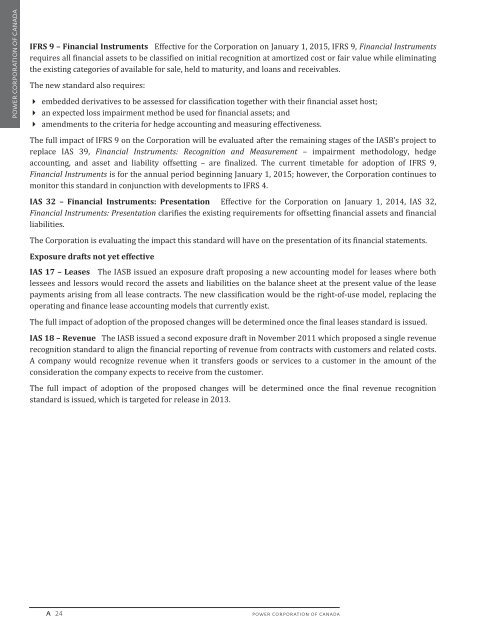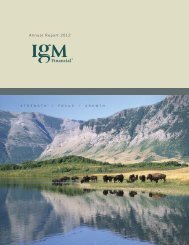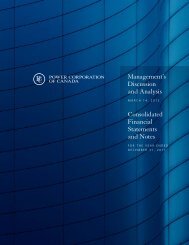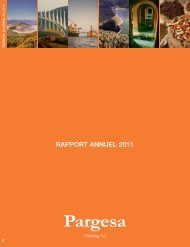- Page 1 and 2: Management’sDiscussion and Analys
- Page 3 and 4: Power Corporation of CanadaTABLE OF
- Page 5 and 6: Power Corporation of CanadaPART APO
- Page 7 and 8: OVERVIEWPower Corporation is a hold
- Page 9 and 10: COMMUNICATIONS-MEDIASquare Victoria
- Page 11 and 12: BASIS OF PRESENTATIONThe 2012 Conso
- Page 13 and 14: CONTRIBUTIONTOOPERATINGEARNINGSFROM
- Page 15 and 16: Other items in 2012 mainly comprise
- Page 17 and 18: ASSETSUNDERADMINISTRATIONAssets und
- Page 19 and 20: EQUITYNon‐participating shares of
- Page 21 and 22: Issuance of non‐participating sha
- Page 23 and 24: SUMMARY OF CRITICAL ACCOUNTING ESTI
- Page 25 and 26: GOODWILLANDINTANGIBLESIMPAIRMENTTES
- Page 27: IFRS 11 - Joint Arrangements Effect
- Page 31 and 32: During the fourth quarter of 2011,
- Page 33 and 34: DISCLOSURE CONTROLS AND PROCEDURESB
- Page 35 and 36: POWER CORPORATION OF CANADACONSOLID
- Page 37 and 38: CONSOLIDATED STATEMENTS OF COMPREHE
- Page 39 and 40: CONSOLIDATED STATEMENTS OF CASH FLO
- Page 41 and 42: NOTE 2 BASIS OF PRESENTATION AND SU
- Page 43 and 44: NOTE 2 BASIS OF PRESENTATION AND SU
- Page 45 and 46: NOTE 2 BASIS OF PRESENTATION AND SU
- Page 47 and 48: NOTE 2 BASIS OF PRESENTATION AND SU
- Page 49 and 50: NOTE 2 BASIS OF PRESENTATION AND SU
- Page 51 and 52: NOTE 2 BASIS OF PRESENTATION AND SU
- Page 53 and 54: NOTE 2 BASIS OF PRESENTATION AND SU
- Page 55 and 56: NOTE 3 CASH AND CASH EQUIVALENTSDec
- Page 57 and 58: 2011 BondsNOTE 4 INVESTMENTS (CONTI
- Page 59 and 60: NOTE 5 FUNDS HELD BY CEDING INSURER
- Page 61 and 62: NOTE 8 OTHER ASSETS (CONTINUED)Chan
- Page 63 and 64: December 31, 2011NOTE 9 GOODWILL AN
- Page 65 and 66: NOTE 10 SEGREGATED FUNDSINVESTMENTS
- Page 67 and 68: NOTE 11 INSURANCE AND INVESTMENT CO
- Page 69 and 70: NOTE 11 INSURANCE AND INVESTMENT CO
- Page 71 and 72: NOTE 11 INSURANCE AND INVESTMENT CO
- Page 73 and 74: NOTE 11 INSURANCE AND INVESTMENT CO
- Page 75 and 76: NOTE 13 DEBENTURES AND DEBT INSTRUM
- Page 77 and 78: NOTE 16 INCOME TAXESEFFECTIVE INCOM
- Page 79 and 80:
NOTE 17 STATED CAPITALISSUED AND OU
- Page 81 and 82:
NOTE 18 SHARE‐BASED COMPENSATION
- Page 83 and 84:
NOTE 20 CAPITAL MANAGEMENTAs a hold
- Page 85 and 86:
NOTE 21 RISK MANAGEMENT (CONTINUED)
- Page 87 and 88:
NOTE 21 RISK MANAGEMENT (CONTINUED)
- Page 89 and 90:
NOTE 21 RISK MANAGEMENT (CONTINUED)
- Page 91 and 92:
NOTE 21 RISK MANAGEMENT (CONTINUED)
- Page 93 and 94:
NOTE 21 RISK MANAGEMENT (CONTINUED)
- Page 95 and 96:
NOTE 21 RISK MANAGEMENT (CONTINUED)
- Page 97 and 98:
NOTE 21 RISK MANAGEMENT (CONTINUED)
- Page 99 and 100:
NOTE 24 PENSION PLANS AND OTHER POS
- Page 101 and 102:
NOTE 24 PENSION PLANS AND OTHER POS
- Page 103 and 104:
NOTE 25 DERIVATIVE FINANCIAL INSTRU
- Page 105 and 106:
NOTE 26 FAIR VALUE OF FINANCIAL INS
- Page 107 and 108:
NOTE 28 EARNINGS PER SHAREThe follo
- Page 109 and 110:
NOTE 30 COMMITMENTS AND GUARANTEESG
- Page 111 and 112:
NOTE 32 SUBSEQUENT EVENTSACQUISITIO
- Page 113 and 114:
NOTE 33 SEGMENTED INFORMATION (CONT
- Page 115 and 116:
To the Shareholders of Power Corpor
- Page 117 and 118:
Power Financial CorporationPART BMa
- Page 119 and 120:
OVERVIEWPower Financial, a subsidia
- Page 121 and 122:
BASISOFPRESENTATIONThe 2012 Consoli
- Page 123 and 124:
CONTRIBUTIONTOOPERATINGEARNINGSFROM
- Page 125 and 126:
RESULTSFROMCORPORATEACTIVITIESResul
- Page 127 and 128:
CONDENSEDSUPPLEMENTARYBALANCESHEETS
- Page 129 and 130:
The carrying value under the equity
- Page 131 and 132:
Financing activities during the twe
- Page 133 and 134:
SUMMARYOFCRITICALACCOUNTINGESTIMATE
- Page 135 and 136:
GOODWILLANDINTANGIBLESIMPAIRMENTTES
- Page 137 and 138:
IFRS 11 - Joint Arrangements Effect
- Page 139 and 140:
RISKFACTORSThere are certain risks
- Page 141 and 142:
During the fourth quarter of 2011,
- Page 143 and 144:
DISCLOSURECONTROLSANDPROCEDURESBase
- Page 145 and 146:
POWER FINANCIAL CORPORATIONCONSOLID
- Page 147 and 148:
CONSOLIDATED STATEMENTS OF COMPREHE
- Page 149 and 150:
CONSOLIDATED STATEMENTS OF CASH FLO
- Page 151 and 152:
NOTE 2 BASIS OF PRESENTATION AND SU
- Page 153 and 154:
NOTE 2 BASIS OF PRESENTATION AND SU
- Page 155 and 156:
NOTE 2 BASIS OF PRESENTATION AND SU
- Page 157 and 158:
NOTE 2 BASIS OF PRESENTATION AND SU
- Page 159 and 160:
NOTE 2 BASIS OF PRESENTATION AND SU
- Page 161 and 162:
NOTE 2 BASIS OF PRESENTATION AND SU
- Page 163 and 164:
NOTE 2 BASIS OF PRESENTATION AND SU
- Page 165 and 166:
NOTE 3 CASH AND CASH EQUIVALENTSDec
- Page 167 and 168:
NOTE 4 INVESTMENTS (CONTINUED)2011
- Page 169 and 170:
NOTE 5 FUNDS HELD BY CEDING INSURER
- Page 171 and 172:
NOTE 8 OTHER ASSETS (CONTINUED)It i
- Page 173 and 174:
NOTE 9 GOODWILL AND INTANGIBLE ASSE
- Page 175 and 176:
NOTE 11 INSURANCE AND INVESTMENT CO
- Page 177 and 178:
NOTE 11 INSURANCE AND INVESTMENT CO
- Page 179 and 180:
NOTE 11 INSURANCE AND INVESTMENT CO
- Page 181 and 182:
NOTE 11 INSURANCE AND INVESTMENT CO
- Page 183 and 184:
NOTE 13 DEBENTURES AND DEBT INSTRUM
- Page 185 and 186:
NOTE 15 OTHER LIABILITIESDecember 3
- Page 187 and 188:
NOTE 16 INCOME TAXES (CONTINUED)A d
- Page 189 and 190:
NOTE 17 STATED CAPITAL (CONTINUED)(
- Page 191 and 192:
NOTE 18 SHARE‐BASED COMPENSATION
- Page 193 and 194:
NOTE 20 CAPITAL MANAGEMENTAs a hold
- Page 195 and 196:
NOTE 21 RISK MANAGEMENT (CONTINUED)
- Page 197 and 198:
NOTE 21 RISK MANAGEMENT (CONTINUED)
- Page 199 and 200:
NOTE 21 RISK MANAGEMENT (CONTINUED)
- Page 201 and 202:
NOTE 21 RISK MANAGEMENT (CONTINUED)
- Page 203 and 204:
NOTE 21 RISK MANAGEMENT (CONTINUED)
- Page 205 and 206:
NOTE 21 RISK MANAGEMENT (CONTINUED)
- Page 207 and 208:
NOTE 22 OPERATING AND ADMINISTRATIV
- Page 209 and 210:
NOTE 24 PENSION PLANS AND OTHER POS
- Page 211 and 212:
NOTE 25 DERIVATIVE FINANCIAL INSTRU
- Page 213 and 214:
NOTE 25 DERIVATIVE FINANCIAL INSTRU
- Page 215 and 216:
NOTE 26 FAIR VALUE OF FINANCIAL INS
- Page 217 and 218:
NOTE 28 EARNINGS PER SHAREThe follo
- Page 219 and 220:
NOTE 30 COMMITMENTS AND GUARANTEESG
- Page 221 and 222:
NOTE 32 SUBSEQUENT EVENTSACQUISITIO
- Page 223 and 224:
NOTE 33 SEGMENTED INFORMATION (CONT
- Page 225 and 226:
INDEPENDENT AUDITOR’S REPORTTo th
- Page 227 and 228:
Great-West Lifeco Inc.PART CManagem
- Page 229 and 230:
MANAGEMENT’S DISCUSSION AND ANALY
- Page 231 and 232:
MANAGEMENT’S DISCUSSION AND ANALY
- Page 233 and 234:
MANAGEMENT’S DISCUSSION AND ANALY
- Page 235 and 236:
MANAGEMENT’S DISCUSSION AND ANALY
- Page 237 and 238:
MANAGEMENT’S DISCUSSION AND ANALY
- Page 239 and 240:
MANAGEMENT’S DISCUSSION AND ANALY
- Page 241 and 242:
MANAGEMENT’S DISCUSSION AND ANALY
- Page 243 and 244:
MANAGEMENT’S DISCUSSION AND ANALY
- Page 245 and 246:
MANAGEMENT’S DISCUSSION AND ANALY
- Page 247 and 248:
MANAGEMENT’S DISCUSSION AND ANALY
- Page 249 and 250:
MANAGEMENT’S DISCUSSION AND ANALY
- Page 251 and 252:
MANAGEMENT’S DISCUSSION AND ANALY
- Page 253 and 254:
MANAGEMENT’S DISCUSSION AND ANALY
- Page 255 and 256:
MANAGEMENT’S DISCUSSION AND ANALY
- Page 257 and 258:
MANAGEMENT’S DISCUSSION AND ANALY
- Page 259 and 260:
MANAGEMENT’S DISCUSSION AND ANALY
- Page 261 and 262:
MANAGEMENT’S DISCUSSION AND ANALY
- Page 263 and 264:
MANAGEMENT’S DISCUSSION AND ANALY
- Page 265 and 266:
Significant assumptions - The disco
- Page 267 and 268:
MANAGEMENT’S DISCUSSION AND ANALY
- Page 269 and 270:
WEALTH MANAGEMENTThe Company provid
- Page 271 and 272:
2012 DEVELOPMENTS up 5% ov
- Page 273 and 274:
MANAGEMENT’S DISCUSSION AND ANALY
- Page 275 and 276:
Sales increased by $72 million to $
- Page 277 and 278:
COMPETITIVE CONDITIONSFinancial Ser
- Page 279 and 280:
MANAGEMENT’S DISCUSSION AND ANALY
- Page 281 and 282:
MANAGEMENT’S DISCUSSION AND ANALY
- Page 283 and 284:
MANAGEMENT’S DISCUSSION AND ANALY
- Page 285 and 286:
MANAGEMENT’S DISCUSSION AND ANALY
- Page 287 and 288:
MANAGEMENT’S DISCUSSION AND ANALY
- Page 289 and 290:
MANAGEMENT’S DISCUSSION AND ANALY
- Page 291 and 292:
MANAGEMENT’S DISCUSSION AND ANALY
- Page 293 and 294:
CONSOLIDATED STATEMENTS OF EARNINGS
- Page 295 and 296:
CONSOLIDATED BALANCE SHEETS(in Cana
- Page 297 and 298:
CONSOLIDATED STATEMENTS OF CASH FLO
- Page 299 and 300:
NOTES TO CONSOLIDATED FINANCIAL
- Page 301 and 302:
NOTES TO CONSOLIDATED FINANCIAL STA
- Page 303 and 304:
NOTES TO CONSOLIDATED FINANCIAL STA
- Page 305 and 306:
NOTES TO CONSOLIDATED FINANCIAL STA
- Page 307 and 308:
NOTES TO CONSOLIDATED FINANCIAL STA
- Page 309 and 310:
NOTES TO CONSOLIDATED FINANCIAL STA
- Page 311 and 312:
NOTES TO CONSOLIDATED FINANCIAL STA
- Page 313 and 314:
NOTES TO CONSOLIDATED FINANCIAL STA
- Page 315 and 316:
NOTES TO CONSOLIDATED FINANCIAL STA
- Page 317 and 318:
NOTES TO CONSOLIDATED FINANCIAL STA
- Page 319 and 320:
NOTES TO CONSOLIDATED FINANCIAL STA
- Page 321 and 322:
NOTES TO CONSOLIDATED FINANCIAL STA
- Page 323 and 324:
NOTES TO CONSOLIDATED FINANCIAL STA
- Page 325 and 326:
NOTES TO CONSOLIDATED FINANCIAL STA
- Page 327 and 328:
NOTES TO CONSOLIDATED FINANCIAL STA
- Page 329 and 330:
NOTES TO CONSOLIDATED FINANCIAL STA
- Page 331 and 332:
NOTES TO CONSOLIDATED FINANCIAL STA
- Page 333 and 334:
NOTES TO CONSOLIDATED FINANCIAL STA
- Page 335 and 336:
NOTES TO CONSOLIDATED FINANCIAL STA
- Page 337 and 338:
NOTES TO CONSOLIDATED FINANCIAL STA
- Page 339 and 340:
NOTES TO CONSOLIDATED FINANCIAL STA
- Page 341 and 342:
NOTES TO CONSOLIDATED FINANCIAL STA
- Page 343 and 344:
NOTES TO CONSOLIDATED FINANCIAL STA
- Page 345 and 346:
NOTES TO CONSOLIDATED FINANCIAL STA
- Page 347 and 348:
NOTES TO CONSOLIDATED FINANCIAL STA
- Page 349 and 350:
NOTES TO CONSOLIDATED FINANCIAL STA
- Page 351 and 352:
NOTES TO CONSOLIDATED FINANCIAL STA
- Page 353 and 354:
NOTES TO CONSOLIDATED FINANCIAL STA
- Page 355 and 356:
INDEPENDENT AUDITOR’S REPORTTo th
- Page 357 and 358:
IGM Financial Inc.PART DManagement
- Page 359 and 360:
IGM Financial Inc.Summary of Consol
- Page 361 and 362:
TABLE 2: CONSOLIDATED OPERATING RES
- Page 363 and 364:
SUMMARY OF CHANGES IN TOTAL ASSETS
- Page 365 and 366:
TABLE 6: SELECTED ANNUAL INFORMATIO
- Page 367 and 368:
TABLE 7: SUMMARY OF QUARTERLY RESUL
- Page 369 and 370:
technology platform, bringing toget
- Page 371 and 372:
50% of their assets in Investors Pr
- Page 373 and 374:
deferred distributions in the form
- Page 375 and 376:
Review of Segment Operating Results
- Page 377 and 378:
TABLE 10 : MORTGAGE BANKING OPERATI
- Page 379 and 380:
Net Investment Income and OtherNet
- Page 381 and 382:
Sale of Mackenzie Subsidiaries• O
- Page 383 and 384:
TABLE 12: ASSETS UNDER MANAGEMENT B
- Page 385 and 386:
Review of Segment Operating Results
- Page 387 and 388:
associated with redemptions. Macken
- Page 389 and 390:
IGM Financial Inc.Consolidated Fina
- Page 391 and 392:
TABLE 17: INVESTMENT IN AFFILIATEth
- Page 393 and 394:
Cash FlowsTable 19 - Cash Flows is
- Page 395 and 396:
impact of all risks on the value of
- Page 397 and 398:
Risk ManagementThe Company is expos
- Page 399 and 400:
Long-Term Debt Maturity Schedule($
- Page 401 and 402:
eceives investment returns on the r
- Page 403 and 404:
Equity Price RiskThe Company is exp
- Page 405 and 406:
differences that may be as a result
- Page 407 and 408:
assets under management, and their
- Page 409 and 410:
year and income taxes recorded in p
- Page 411 and 412:
IAS 19 Employee BenefitsThe IASB is
- Page 413 and 414:
Other InformationTRANSACTIONS WITH
- Page 415 and 416:
Consolidated Financial Statements75
- Page 417 and 418:
Independent Auditor’s ReportTo th
- Page 419 and 420:
Consolidated Statements of Comprehe
- Page 421 and 422:
Consolidated Statements of Changes
- Page 423 and 424:
Notes to Consolidated Financial Sta
- Page 425 and 426:
2. SUMMARY OF SIGNIFICANT ACCOUNTIN
- Page 427 and 428:
2. SUMMARY OF SIGNIFICANT ACCOUNTIN
- Page 429 and 430:
3. DISCONTINUED OPERATIONSOn Novemb
- Page 431 and 432:
6. LOANSCONTRACTUAL MATURITY1 YEAR
- Page 433 and 434:
9. INVESTMENT IN AFFILIATEInvestmen
- Page 435 and 436:
11. GOODWILL AND INTANGIBLE ASSETS
- Page 437 and 438:
14. EMPLOYEE BENEFITS (continued)De
- Page 439 and 440:
15. INCOME TAXESIncome tax expense
- Page 441 and 442:
17. SHARE CAPITAL (continued)Normal
- Page 443 and 444:
19. SHARE-BASED PAYMENTS (continued
- Page 445 and 446:
21. RISK MANAGEMENT (continued)Cred
- Page 447 and 448:
21. RISK MANAGEMENT (continued)Cred
- Page 449 and 450:
22. DERIVATIVE FINANCIAL INSTRUMENT
- Page 451 and 452:
23. FAIR VALUE OF FINANCIAL INSTRUM
- Page 453 and 454:
23. FAIR VALUE OF FINANCIAL INSTRUM
- Page 455 and 456:
25. CONTINGENT LIABILITIES, COMMITM
- Page 457 and 458:
27. SEGMENTED INFORMATION (continue
- Page 459 and 460:
Pargesa Holding SAPART EPOWER CORPO
- Page 461 and 462:
Pargesa Group - Financial informati
- Page 463 and 464:
Economic analysis of Pargesa’s ne
- Page 465 and 466:
GDF SUEZGDF Suez, a world energy le
- Page 467 and 468:
CorporateInformationStock ListingsS






